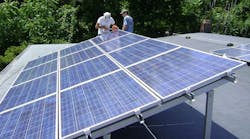Q: There has been much discussion over disruptive technologies for utilities which can significantly change their operating business models. One such topic is Distributed Generation/Roof top PV. How should utilities view this- An Opportunity OR Threat (to their traditional business of selling electrons)? In any case, what are all technological (such as relay operations for reverse power flow etc) & Regulatory constraints which any utility would face? And what should be best approach taken considering the penetration of renewables by 2020 or 2025?
India
A: Distributed generation is a broad category and includes dispatchable backup generation such as diesel generators as well as intermittent generation such as PV solar and wind. Distributed generation (DG) that can genuinely serve as back-up in a blackout by providing a meaningful and controllable level of power, on-demand, for a useful duration, and without dependence upon or back-flow to the rest of the grid that endangers workers or other customers, is of benefit to everyone and a threat to no one. Unfortunately, the vast majority of DG is not configured in this way -- particularly intermittent wind and solar power generation. Just as a diesel generation without fuel storage is not dispatchable or reliable, neither is intermittent wind or solar without electricity storage. And none of the DG options above are useful and safe for back-up generation unless the proper transfer switches are installed to isolate them from the grid during an outage and the necessary dedicated circuits and mechanisms exist to limit loads to the back-up capacity. Switches, dedicated circuits, and especially electricity storage are very expensive components of a proper DG system that are typically not installed. The levelized cost of electricity (LCOE) of wind and solar power at residential and even commercial scale is already higher than other DG and grid generation alternatives even without these options. (See EPRI 2012 projections at http://www.epri.com/abstracts/Pages/ProductAbstract.aspx?productId=000000000001026656 and DOE Transparent Cost Database at http://en.openei.org/apps/TCDB/ for latest LCOE analysis.)
The mission statement for electric power utilities has always included “reliable, affordable, and safe” power. It is the customers as well as the utilities that should set themselves against anything that is disruptive to this troika. High-LCOE, arbitrarily intermittent, non-dispatchable electricity from solar and wind installations without the requisite back-up and buffering undermines all of the above, especially when coupled with must-take power requirements and retail-price net metering and installation and production subsidies financed by taxes and rate increases. Using the grid itself as the buffering and backup mechanism merely shifts the backup and buffering burdens and costs improperly to other generation and ancillary service providers rather than allotting them to the disruptive and destabilizing intermittent generators themselves.
What would really be disruptive in a positive way would be to move away from a producer-centric cost recovery model to a consumer-centric power valuation model. Instead of politicians and commissions deciding how to socialize costs of politically-favored projects to politically-unfavored ones, electric generation of all types would compete on a level playing field, bid for transmission ISO block times, and be priced by the market for their demonstrated characteristics of reliability (precise delivery on their bids), load-following (dispatchability/ramp-rate/reserve suitability), quality (voltage/frequency/power factor stability), and externalities valued by consumers such as health (lifecycle polluting emissions per kWh), climate impact (lifecycle GHG emissions per kWh), environmental impact (land/water/biodiversity footprint per kWh), and safety (human and animal deaths per kWh).
No form of generation or corporate institution should be propped up by subsidies or guaranteed cost recovery. The utilities should be striving to provide power that is of the highest value to consumers at the lowest cost to themselves, not looking to harvest the most federal and state handouts nor relying on state-imposed rate levies to guarantee ROI for projects that cannot be justified on their own merits by a sound business case analysis. Of course, this is quite a Gordian Knot to unravel at this point in our highly-regulated and politicized status quo.
T. A. "Ike" Kiefer
Contracts Administrator
East Mississippi Electric Power Assoc.


